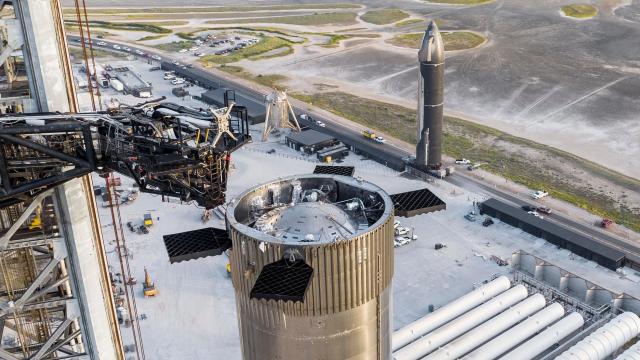Updated documents filed to the U.S. Federal Communications Commission suggest SpaceX might actually use its Mechazilla launch tower and chopstick arms to catch a returning Starship booster rocket during the first orbital flight test of its upcoming giant rocket.
We don’t know when Starship might make its first attempt to reach orbit, but when it finally happens, this launch won’t be a dull affair, that’s for sure. The original plan for the fully stacked Starship system, as articulated in a SpaceX application filed to the Federal Communications Commission (FCC) in May 2021, stated that both stages of the rocket would end up in the ocean; the booster would splash down in the Gulf of Mexico some 32 km from shore, while the upper stage, after completing a partial orbit of Earth, would come down off the northwest coast of Kauai, Hawaii.
That scenario is still very much possible, but a small tweak to the FCC application suggests a different outcome for the booster stage. Upon launching from Starbase in Boca Chica, Texas, the Super Heavy booster will separate from the upper stage and “then perform a partial return and land in the Gulf of Mexico or return to Starbase and be caught by the launch tower,” according to the updated launch profile. That part about the booster being caught by the launch tower — that wasn’t there before, and it was noticed by the watchful eye of Michael Baylor from NASASpaceFlight.com.

The FCC application is specific to the first orbital launch of Starship, so CEO Elon Musk must have this goal in mind for the booster’s maiden voyage. That’s a big ask, as nothing like this has ever been attempted before. Sure, the company can land Falcon 9 booster stages like it’s nobody’s business, but the Starship booster is a horse of a different colour. In addition to returning to Starbase, the 70.10 m-tall booster will have to orient itself above the 122-metre tall launch mount and perform a controlled descent. A pair of arms, dubbed “chopsticks,” will then guide the booster to a safe vertical landing.
Maybe something like this pic.twitter.com/PUBLdaewt8
— Elon Musk (@elonmusk) January 20, 2022
Writing in Teslarati, Eric Ralph explains how incredibly risky this will be — especially given that the catch attempt could happen during the inaugural launch:
In the event of larger anomalies during a landing attempt, Starship or Super Heavy could accidentally impact the launch tower, damaging or even outright destroying the skyscraper-sized structure. Ultimately, the immense risk posed by any catch attempt means that unless SpaceX has miraculously gotten the design of everything involved nearly perfect on its first try, the company will have to be extraordinarily cautious and expend a large number of ships and boosters to avoid rendering its only Starship launch tower unusable.
At least to some extent, SpaceX likely knows this and Super Heavy would likely need to be in excellent health and perform perfectly during the ascent and boostback portions of its launch debut to be cleared for a catch attempt. Ultimately, Starship’s first orbital launch could end up being even more of a spectacle than it’s already guaranteed to be.
Ralph is correct in pointing out that only one Starship launch tower exists, but SpaceX is building a second at Kennedy Space Centre in Florida. Ideally, SpaceX would like to use both towers to stack, launch, and catch the booster. The private company is currently under contract with NASA to develop the system as a means for transporting astronauts to the lunar surface, but the bigger picture for SpaceX is to have the rocket deliver cargo and passengers to orbit, the Moon, Mars, and potentially elsewhere in the solar system.
Under the updated FCC filing, SpaceX is also seeking permission to use Starlink terminals to enable in-flight telemetry. “Multiple Starlink terminals will be fitted to each vehicle [both the booster and the upper stage] to ensure a clear view of the SpaceX satellite constellation through the Starship flight profile,” according to the updated application. “The terminals will use the same antenna and communications electronics as SpaceX’s previously authorised consumer terminals but with a revised enclosure and mounting that is suitable for the mission profile.”
As to when Starship might fly to orbit for the first time, that’s unclear. Earlier this week, an accumulation of gas beneath the Super Heavy Booster 7 prototype exploded unexpectedly during ground tests. The damage is “minor,” according to Musk, who said the booster might have to be transported to the high bay for inspections. Musk had hoped to launch the fully stacked Starship this month, but that seems increasingly unlikely.
